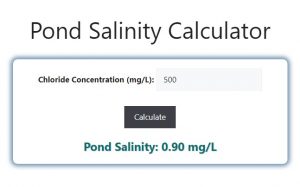About Pond Salinity Calculator (Formula)
Pond salinity refers to the concentration of salts in pond water. It’s an important parameter for the health of aquatic life and plants. Too much or too little salt can disrupt the ecological balance in a pond, especially for fish and certain plant species. A pond salinity calculator helps determine the exact salinity levels using chloride ion concentration, making it easier to maintain a healthy pond environment.
Formula
The formula for calculating pond salinity is:
Pond Salinity (PS) = 0.0018066 * Chloride ion concentration (Cl-)
Where:
- PS = Pond salinity
- Cl- = Chloride ion concentration in mg/L
How to Use
Using a pond salinity calculator is straightforward:
- Measure the chloride ion concentration in the pond water (usually in mg/L).
- Input the value of chloride ion concentration into the calculator.
- Apply the formula to calculate salinity (PS = 0.0018066 * Cl-).
- The result will give you the salinity of your pond water.
Example
Let’s say you measure the chloride ion concentration in your pond to be 500 mg/L. Using the formula:
Pond Salinity = 0.0018066 * 500 = 0.9033 g/L
This means the salinity of the pond is 0.9033 g/L.

FAQs
- Why is pond salinity important?
Pond salinity affects the health of aquatic life, especially fish and plants that are sensitive to salt levels. - How do I measure chloride ion concentration in my pond?
You can measure chloride ion concentration using a water testing kit or by sending a sample to a lab. - What is the ideal salinity level for a pond?
The ideal salinity level varies, but most freshwater ponds should have salinity levels below 1 g/L. - Can high salinity harm fish?
Yes, excessive salinity can harm fish by affecting their osmoregulation processes. - How does salinity affect pond plants?
High salinity levels can stunt plant growth and even cause some species to die off. - What happens if the salinity is too low?
Low salinity can make fish vulnerable to disease, as some salinity is needed for osmotic balance. - Can I use table salt to adjust pond salinity?
It is not recommended to use table salt. Use pure pond salt designed for aquatic environments. - How often should I check pond salinity?
It is best to check pond salinity every few months or after heavy rainfall, which can dilute salinity. - Can rainwater affect pond salinity?
Yes, rainwater can dilute the salinity, lowering salt concentrations in the pond. - Is there a difference between saltwater and freshwater ponds in salinity?
Yes, saltwater ponds have higher salinity levels than freshwater ponds. The pond salinity calculator is typically used for freshwater systems. - Can I use a salinity calculator for saltwater ponds?
Yes, but the chloride ion concentration and salinity levels will be much higher in saltwater environments. - What is the difference between chloride and salinity?
Chloride ions are a major component of salts dissolved in water, while salinity is the overall concentration of these dissolved salts. - What is the unit of pond salinity?
Pond salinity is usually expressed in grams per liter (g/L) or parts per thousand (ppt). - Can temperature affect pond salinity?
Yes, higher temperatures can cause evaporation, which concentrates salts and increases salinity. - How can I lower high pond salinity?
You can lower salinity by adding freshwater to dilute the concentration of salts. - Is there a natural way to manage pond salinity?
Planting salt-tolerant vegetation around the pond or using rainwater collection can naturally help manage salinity. - What should I do if pond salinity fluctuates a lot?
Try to maintain a balance by adding freshwater periodically and avoid overuse of chemicals or salts. - Can high salinity cause algae blooms?
High salinity may affect nutrient balance, leading to conditions that could support algae growth. - Is pond salinity related to pH levels?
While not directly related, both salinity and pH levels affect water quality and the health of the pond ecosystem. - How does pond salinity impact aquatic invertebrates?
Some invertebrates are more sensitive to changes in salinity, which can impact their survival rates.
Conclusion
A pond salinity calculator is a practical tool for maintaining the right balance of salts in your pond, ensuring the well-being of aquatic life. By understanding and managing salinity levels, you can create a stable and healthy environment for your pond’s ecosystem. Regular monitoring, using the salinity formula, will help you make informed decisions about water quality and aquatic care.